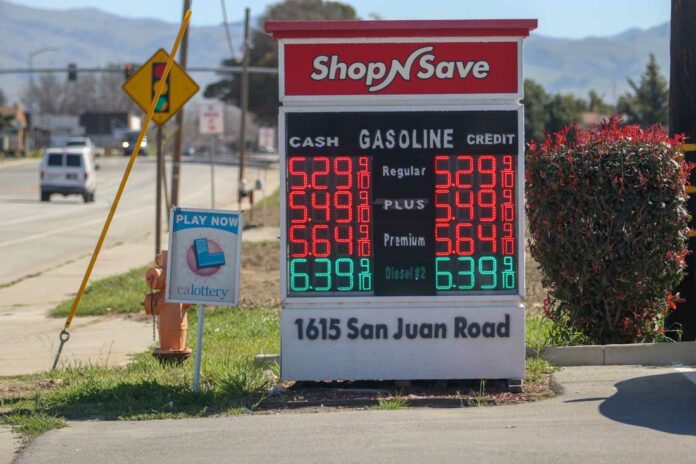
California’s average price for a gallon of gasoline is the highest in the United States, with Santa Clara County among the most expensive in the state, according to the Automobile Association of America.
As of March 8, the average price for regular gas in California was $5.44 per gallon, the highest ever recorded, according to AAA, with San Benito County slightly under at $5.33.
City Gasoline, 5 San Benito St. in Hollister, has the least expensive price as of March 8, at $5.08 a gallon for regular, according to GasBuddy.com, which tracks prices in real-time. Prices go up dramatically from there, up to $5.90 for regular and more than $6 for premium.

Following California is Hawaii, Nevada, Oregon, Washington and Alaska.
Hollister resident Alyssa Cabrel said with her daily 30-minute commute, plus regular road trips to Arizona, the latest price increase is eating up “half my paycheck.” As of March 8, it costs her more than $60 to fill the tank on her mid-size SUV, Cabrel said while in line at the Safeway gas station on Tennant Avenue in Morgan Hill.
“I just have to budget more,” said Cabrel, who commutes from Hollister to Morgan Hill for work every day. She also travels to Arizona periodically for family visits. “It doesn’t seem to be getting better. It’s not good to add onto everybody’s other stresses.”
The Hollister Free Lance also reached out to its Facebook followers to see how the skyrocketing gas prices are affecting their daily lives.
George Jacinto replied, “I sure could go for gas prices under $4 and a mean tweet here and there right about now.”
Suzie Yamanishi added, “(Don’t) come to California, look at our gas prices.”
AAA said an increase in gas demand, along with a reduction in total supply, is contributing to price increases, but rising oil prices continue to play a leading role in pushing prices higher. Prices at the pump will likely continue to rise as crude prices continue to climb. The price of crude oil closed at about $125 per barrel March 8, which is up from about $89 a month ago.
Russia’s invasion of Ukraine is a major factor in the skyrocketing prices, analysts say.
On March 8, President Joe Biden announced the United States is banning imports of Russian oil, natural gas and coal.
The International Energy Agency recently announced a release of crude oil from 31 countries’ reserves, including the U.S., Germany, Canada, South Korea and Mexico, to help counter the impact of rising crude prices. However, it admitted that the release is small in comparison to what flows daily from Russia, which exports about five million barrels a day of crude oil globally.
According to U.S. Census data, Hollister workers average a 35.5-minute commute one way, meaning a large amount of time spent burning gas.









